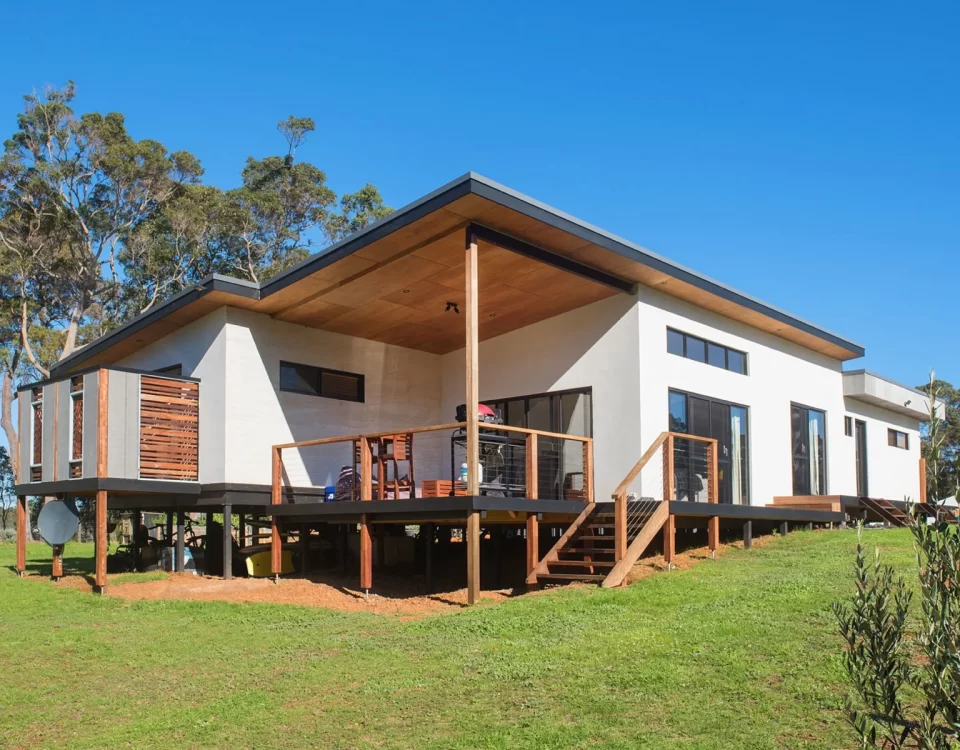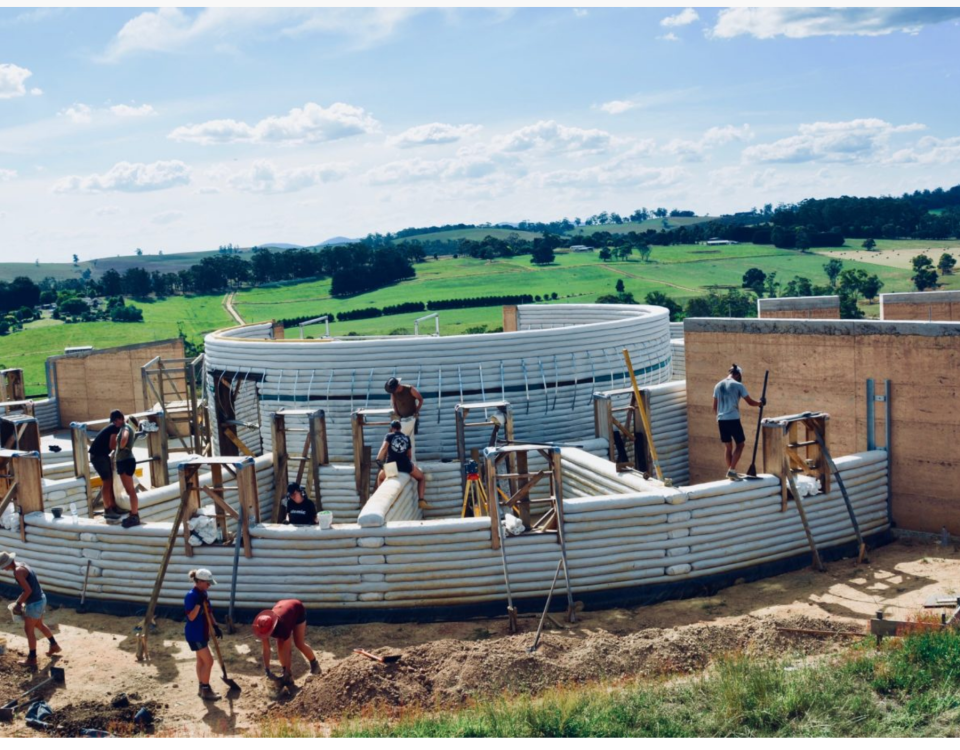
Passive Cooling – What we can learn from the tropics
16/11/2023
Sustainable Building 101 Webinar Series launched!
08/01/2024It’s becoming clearer that individual actions, particularly across the housing and building sectors, can have marked impacts on the embodied carbon of our lifestyles and the way those homes continue to interact with the fossil-fuel based system for years to come.
The choice of materials we choose to utilise in erecting our future buildings play a huge factor in how it plays its role in saving our environment. Different building materials emit different levels of carbon footprint when being created. Higher embodied materials such as concrete, steel, and insulation contribute to the 39% of global energy related carbon emissions.
To combat climate change we have to focus more on ways to draw carbon out of the atmosphere. The way to do this in building is to use carbon-sequestering materials. Plants and trees take up carbon dioxide as they grow via photosynthesis. If we use them in our buildings this carbon is then stored. Low density natural building methods such as light earth and straw bale are good at locking up carbon, as is any timber that is used. To finish natural walls (at least on the inside) a natural clay or lime plaster can be used. This is a beautiful, soft and breathable finish that has many benefits.
Lime Plaster
Lime is a historic building material that was used in many parts of the world as a traditional mortar, render, plaster and paint. It is formed by burning limestone or shells in a kiln to create highly reactive burnt lime or quicklime. The quicklime is then slaked with water to create lime putty, hydrated lime powder or hydraulic lime powder. If you live in a house built before 1919 it is likely to have been plastered using lime — although just because your house may have been built later than this it doesn’t mean lime won’t have been used.
Pure natural air limes set or cure slowly with exposure to the atmosphere whereas hydraulic limes can set quickly with water. Pozzolans can be added to natural air limes to create hydraulic lime while it still functions as anti-fungal and anti-microbial. This is what the Romans did, creating “Roman cement”. Portland cement is another product that does this. Portland cement is a very specific type of hydraulic lime that has some advantages but also many disadvantages to traditional lime.
External lime renders can provide water resistant finishes when directly applied to protected natural wall systems, such as LEM, straw bale, hempcrete, cob and adobe. A sacrificial, multi coat lime wash finish can be applied over the top of the render, pigmented to taste and reapplied as required. Traditionally in the UK this lime wash was reapplied yearly in May.
Lime plasters can be used internally, but in this situation clay plasters are more suited. Although lime will help regulate humidity, clay is much better at this. Clay also has lower embodied energy and is nicer to the touch. Clay is highly vapour permeable or ‘breathable’. This means it allows the ready transmission of water vapour, and so prevents the build-up of moisture within the walls.
Clay Plaster
Basic earth plaster is made by mixing clay, straw and sand together until they form a nice gooey stodge. If you are using your own dirt, you need to know how much clay is in it since most soils are usually a mixture of clay, silt and sand. The very vague (and highly inconsistent) rule of thumb is one part clay, one part straw and one part sand. Clay introduces thermal mass into buildings and if designed according to passive solar principles this can aid in thermal regulation i.e. free night time heat in winter and lunch time ‘coolth’ in summer.
Clay is hygroscopic. That means it can absorb high humidity from the air, and release it when conditions reverse. The result is that internal humidity is moderated leading to a more uniform and comfortable internal environment. Clay also moderates the moisture content of adjacent cellulose materials such as timber or plant fibres which reduces their likelihood of decomposition
Clay plasters can be applied over many surfaces and clay renders can be used eternally on walls well protected from the weather. Clay paints or alises can also be used for decorative effect on protected walls. Clay plasters can be applied over cob, adobe, rammed earth, light earth, straw bale, hempcrete, timber lath (use heavy straw clay mix), reed matting lath or even plasterboard (with the correct key).
Some people add horse or cow manure, casein-borax glue, paper pulp cellulose (watch shrinkage) or wheat paste (wallpaper size) to increase durability and reduce dusting while you can also add natural mineral pigments or mica to the final coat for aesthetic effect.
Tadelakt
Tadelakt has the longest history of any plastering technique in the world, stretching back approximately 2,000 years. The word means ‘to rub in’ and comes from the Arabic word tadleek, which translates as ‘to rub or massage’. Tadelakt is a shinny water repellent finish to lime plaster that was traditionally used in Moroccan bathing room interiors. The lime plaster is compressed and polished with a hard stone and olive oil soap in a very labour intensive process.
The first coat is applied very thinly as a scrape coat to adhere to the primer. When it has dried after an hour or two the second Tadelakt coat is applied a little bit thicker to create a smooth surface. Once applied, switch to plastic trowels to flatten and compress the Tadelakt.
Safety notes
If you are going to be using lime there are some important points to consider
- Safety precautions must be taken as lime is highly alkaline and can cause serious injury. Personal protective equipment (PPE) must be worn by all individuals who come in contact with lime
- Bagged lime should be obtained fresh from the plant as they are bagging it, to avoid the curing process beginning in the bag
- All fixings and metal exposed to lime to be stainless steel
- Eaves/ verandahs are required as the primary weather protection for durability
- Only apply render, plaster or wash to dry walls although the substrate does need to be misted down first
- Must cure slowly in a moist, protected environment, avoid direct sun, freezing temperatures and wind as it cures
- Needs a good key. This varies by substrate
- May need plastic mesh in the render
- Plaster needs to mature for at least 3 months before use
- Pigment can be added for aesthetic effect
- If applying a mineral silicate paint, the lime render must be fully carbonated first
- Use well graded sand and animal or plant fiber in renders and plasters
- Lime render needs to be 25-30mm thick and applied in 3 coats according to most standards
Some useful references include:
Thanks to Ullenberg Eco-Architects for references used in this blog
- Stafford Holmes & Michael Wingate. Building With Lime. Practical Action Publishing. 2019.
- Cedar Rose Guelberth & Dan Chiras. The Natural Plaster Book. New Society Publishers, 2003.
- Adam Weismann & Katy Bryce. Using Natural Finishes. Green Books. 2008.
- Michael Henry & Tina Therrien. Essential Natural Plasters. New Society Publishers, 2018.
- Adam Weismann and Katy Bryce. Using Natural Finishes: Lime & Earth Based Plasters, Renders & Paints. Green Books, 2008.
- Gernot Minke. Building With Earth. Birkhäuser Verlag, 2013.
- Jacob Racusin and Ace McArleton. The Natural Building Companion. Chelsea Green Publishing, 2012.
- Joseph F. Kennedy, Michael G. Smith and Catherine Wanek, Editors. The Art of Natural Building Second Edition. New Society Publishers, 2015.
- Franz Volhard. Light Earth Building. Birkhäuser Verlag, 2016.
- Joseph M. Tibbets. The Earthbuilders’ Encyclopedia. Southwest Solaradobe School, 1988.
- Clarke Snell & Tim Callahan. Building Green. Lark, 2009.
- Ianto Evans, Michael G. Smith and Linda Smiley. The Hand-Sculpted House. Chelsea Green Publishing, 2002.
- Adam Weismann and Katy Bryce. Building with Cob. Green Books, 2006.
- Paul Lacinski and Michael Bergeron. Serious Straw Bale. Chelsea Green Publishing, 2000.
- Barbara Jones. Building with Straw Bales. Green Books, 2015.
- Chris Magwood, Peter Mack & Tina Therrien. More Straw Bale Building. New Society Publishers, 2005.
- Lydia Doleman. Essential Light Straw Clay Construction. New Society Publishers, 2017.




